2010 MERCEDES-BENZ CL550 tension
[x] Cancel search: tensionPage 10 of 500

Driving
Abroad ........................................... 401
Hydroplaning ................................. 400
Instructions ........................... 285, 397
In winter ........................................ 396
Problems ....................................... 288
Safety systems
................................ 56
Systems ......................................... 301
Through standing water .................400
With DISTRONIC PLUS ................... 313
Driving and parking
Safety notes .................................. 285
Driving off .................................. 287, 400
Driving safety systems ....................... 56
ABS .................................................. 57
Adaptive Brake ................................ 59
Adaptive Brake Lights ...................... 59
BAS .................................................. 57
BAS PLUS ........................................ 57
EBP .................................................. 59
ESC .................................................. 59
ETS/4-ETS ....................................... 60
PRE-SAFE ®
Brake ............................. 62
Driving systems
Active Body Control (ABC) ............. 319
Advanced Parking Guidance ..........327
AIRMATIC ...................................... 317
All-wheel drive (4MATIC) ................ 321
Blind Spot Assist ............................ 335
Cruise control ................................ 302
DISTRONIC PLUS ........................... 304
Hill-start assist system .................. 315
HOLD function ............................... 316
Night View Assist ........................... 333
Park Assist ..................................... 324
Parktronic system ..........................321
Rear view camera .......................... 332
Driving tips, automatic
transmission ...................................... 295
DVD, audio ......................................... 162
DVD, video ......................................... 174 E
EBP (Electronic Brake
Proportioning) ...................................... 59
Electrical system
Improper work on or
modifications
................................... 22
Power outlets ................................. 353
Electrical system (Technical data)
see Vehicle specification
Electronic parking brake ..................288
Electronic Stability Control see ESC
Electronic Traction System
see ETS/4-ETS
Emergency, in case of
First aid kit ..................................... 412
Flat tire .......................................... 465
Hazard warning flasher ..................278
Roadside Assistance ................ 21, 356
Towing the vehicle .........................473
Emergency calls
Tele Aid .......................................... 354
Telephone ...................................... 137
Emergency engine shutdown ...........478
Emergency operations
Remote door lock (Tele Aid) ........... 359
Remote door unlock (Tele Aid) ....... 359
Trunk lid, emergency release .........260
Emergency Tensioning Device
see ETD
Emission control ............................... 401
Information label ............................ 481
System warranties ........................... 20
Engine
Break-in recommendations ............366
Cleaning ......................................... 405
Compartment ................................ 368
Malfunction indicator lamp ............ 457
Messages in the multifunction
display ........................................... 442
Number .......................................... 481
Starting .......................................... 285
Turning off ..................................... 290
Engine (Technical data)
see Vehicle specification
Engine coolant
see Coolant 8
Index 216_AKB; 3; 90, en-US
d2ureepe,
Version: 2.11.8.1 2009-05-15T11:47:50+02:00 - Seite 8
Page 11 of 500

Engine oil
Adding ........................................... 371
Additives ........................................ 493
Checking level ............................... 369
Consumption ................................. 369
Messages in the multifunction
display ........................................... 444
Oil dipstick .....................................
369
Recommended engine oils and oil
filter ............................................... 492
ESC (Electronic Stability Control) ......59
ETS/4-ETS ....................................... 60
Messages in the multifunction
display ........................... 429, 430, 435
Warning lamp ................................. 456
ETD (Emergency Tensioning
Device) ................................................. 48
Safety guidelines ............................. 39
ETS/4-ETS (Electronic Traction
System) ................................................ 60
Express operation Power windows .............................. 282
Tilt/sliding sunroof ........................345
Exterior lamp switch ......................... 275
Exterior rear view mirrors ................271
Fold-in function .............................. 273
Parking position ............................. 272
Power folding ................................. 273
Exterior view of vehicle ......................26 F
Fastening the seat belts .....................47
First aid kit .........................................
412
Flat tire
............................................... 465
Lowering the vehicle ......................469
Mounting the spare wheel ............. 466
Preparing the vehicle .....................465
Spare wheel ........................... 465, 490
Floormats ........................................... 363
Fluids
ABC fluid ................................ 371, 491
Automatic transmission fluid ......... 491
Brake fluid ..................................... 491
Capacities ...................................... 490
Engine coolant ............................... 491
Engine oil ....................................... 490Power steering fluid .......................
491
Washer and headlamp cleaning
system ........................................... 492
Fog lamps ........................................... 277
Messages in the multifunction
display
................................... 446, 448
Fold-in function for exterior rear
view mirrors ...................................... 273
Four-wheel drive see All-wheel drive (4MATIC)
Front air bags
see Air bags
Front passenger front air bag ............ 40
Messages in the multifunction
display ........................................... 417
Front passenger front air bag off
indicator lamp ............................. 41, 459
Fuel ..................................................... 366
Additives ........................................ 494
Capacity, fuel tank ......................... 491
Drive sensibly–safe fuel .................397
Fuel consumption statistics ...........204
Fuel filler flap and cap ................... 367
Fuel tank reserve warning lamp .....457
Premium unleaded gasoline ...........493
Refueling ........................................ 366
Requirements ................................ 494
Fuel filler flap ..................................... 367
Fuel gauge ......................................... 301
Fuels, coolants, lubricants etc. ........490
Fuel tank Capacity ........................................ 491
Fuel filler flap and cap ................... 367
Refueling ........................................ 366
Fuses .................................................. 476 G
Garage door opener .......................... 360
Gasoline see Fuel
GAWR (Gross Axle Weight Rating) ...394
Gear range ......................................... 295
Indicator ........................................ 295
Limiting .......................................... 297
Shifting into optimal ......................298
Gear selector lever ............................291
Cleaning ......................................... 409 Index
9 216_AKB; 3; 90, en-US
d2ureepe,
Version: 2.11.8.1 2009-05-15T11:47:50+02:00 - Seite 9
Page 38 of 500
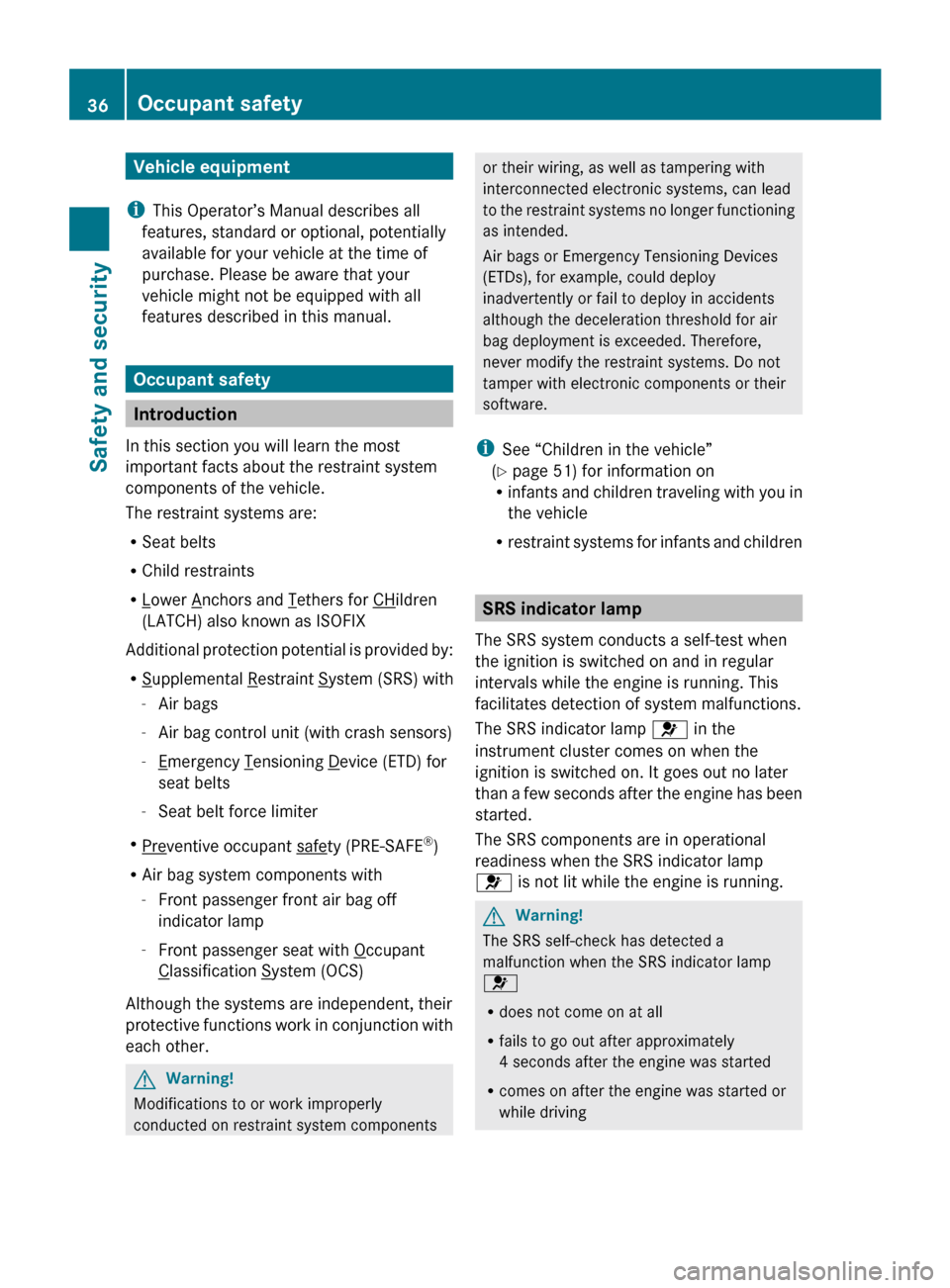
Vehicle equipment
i This Operator’s Manual describes all
features, standard or optional, potentially
available for your vehicle at the time of
purchase. Please be aware that your
vehicle might not be equipped with all
features described in this manual. Occupant safety
Introduction
In this section you will learn the most
important facts about the restraint system
components of the vehicle.
The restraint systems are:
R Seat belts
R Child restraints
R Lower Anchors and Tethers for CHildren
(LATCH) also known as ISOFIX
Additional protection
potential is provided by:
R Supplemental Restraint System (SRS) with
- Air bags
- Air bag control unit (with crash sensors)
- Emergency Tensioning Device (ETD) for
seat belts
- Seat belt force limiter
R Preventive occupant safety (PRE-SAFE
®
)
R Air bag system components with
-Front passenger front air bag off
indicator lamp
- Front passenger seat with Occupant
Classification System (OCS)
Although the systems are independent, their
protective functions
work in conjunction with
each other. G
Warning!
Modifications to or work improperly
conducted on restraint system components or their wiring, as well as tampering with
interconnected electronic systems, can lead
to
the
restraint systems no longer functioning
as intended.
Air bags or Emergency Tensioning Devices
(ETDs), for example, could deploy
inadvertently or fail to deploy in accidents
although the deceleration threshold for air
bag deployment is exceeded. Therefore,
never modify the restraint systems. Do not
tamper with electronic components or their
software.
i See “Children in the vehicle”
(Y page 51) for information on
R infants and children traveling with you in
the vehicle
R restraint systems for infants and children SRS indicator lamp
The SRS system conducts a self-test when
the ignition is switched on and in regular
intervals while the engine is running. This
facilitates detection of system malfunctions.
The SRS indicator lamp 6 in the
instrument cluster comes on when the
ignition is switched on. It goes out no later
than a
few seconds after the engine has been
started.
The SRS components are in operational
readiness when the SRS indicator lamp
6 is not lit while the engine is running. G
Warning!
The SRS self-check has detected a
malfunction when the SRS indicator lamp
6
R does not come on at all
R fails to go out after approximately
4 seconds after the engine was started
R comes on after the engine was started or
while driving 36
Occupant safety
Safety and security
216_AKB; 3; 90, en-US
d2ureepe,
Version: 2.11.8.1 2009-05-15T11:47:50+02:00 - Seite 36
Page 41 of 500
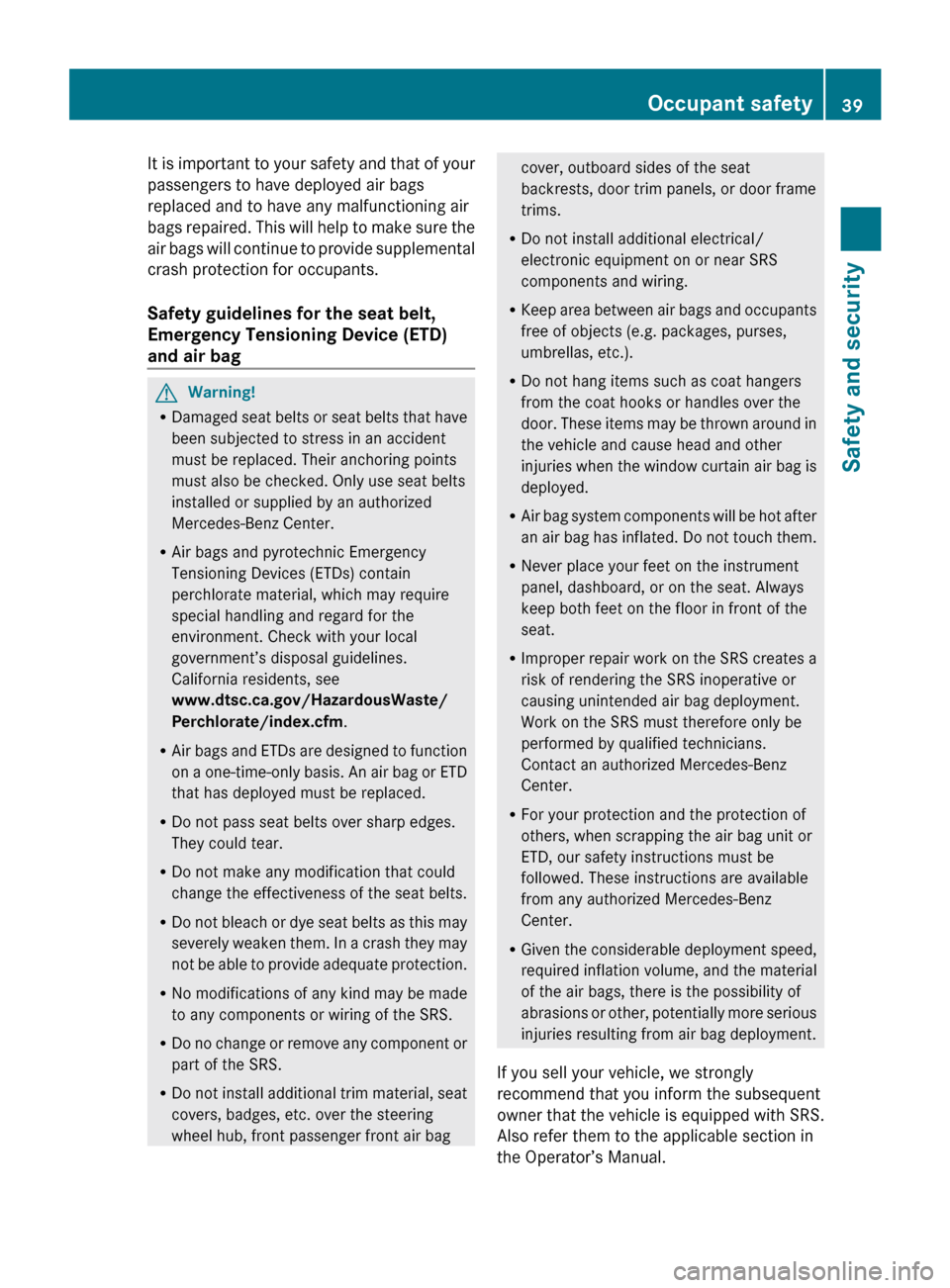
It is important to your safety and that of your
passengers to have deployed air bags
replaced and to have any malfunctioning air
bags
repaired.
This will help to make sure the
air bags will continue to provide supplemental
crash protection for occupants.
Safety guidelines for the seat belt,
Emergency Tensioning Device (ETD)
and air bag G
Warning!
R Damaged seat
belts or seat belts that have
been subjected to stress in an accident
must be replaced. Their anchoring points
must also be checked. Only use seat belts
installed or supplied by an authorized
Mercedes-Benz Center.
R Air bags and pyrotechnic Emergency
Tensioning Devices (ETDs) contain
perchlorate material, which may require
special handling and regard for the
environment. Check with your local
government’s disposal guidelines.
California residents, see
www.dtsc.ca.gov/HazardousWaste/
Perchlorate/index.cfm.
R Air bags and ETDs are designed to function
on a one-time-only basis. An air bag or ETD
that has deployed must be replaced.
R Do not pass seat belts over sharp edges.
They could tear.
R Do not make any modification that could
change the effectiveness of the seat belts.
R Do not bleach or dye seat belts as this may
severely weaken them. In a crash they may
not be able to provide adequate protection.
R No modifications of any kind may be made
to any components or wiring of the SRS.
R Do no change or remove any component or
part of the SRS.
R Do not install additional trim material, seat
covers, badges, etc. over the steering
wheel hub, front passenger front air bag cover, outboard sides of the seat
backrests, door trim panels, or door frame
trims.
R Do not install additional electrical/
electronic equipment on or near SRS
components and wiring.
R Keep area
between air bags and occupants
free of objects (e.g. packages, purses,
umbrellas, etc.).
R Do not hang items such as coat hangers
from the coat hooks or handles over the
door. These items may be thrown around in
the vehicle and cause head and other
injuries when the window curtain air bag is
deployed.
R Air bag system components will be hot after
an air bag has inflated. Do not touch them.
R Never place your feet on the instrument
panel, dashboard, or on the seat. Always
keep both feet on the floor in front of the
seat.
R Improper repair work on the SRS creates a
risk of rendering the SRS inoperative or
causing unintended air bag deployment.
Work on the SRS must therefore only be
performed by qualified technicians.
Contact an authorized Mercedes-Benz
Center.
R For your protection and the protection of
others, when scrapping the air bag unit or
ETD, our safety instructions must be
followed. These instructions are available
from any authorized Mercedes-Benz
Center.
R Given the considerable deployment speed,
required inflation volume, and the material
of the air bags, there is the possibility of
abrasions or other, potentially more serious
injuries resulting from air bag deployment.
If you sell your vehicle, we strongly
recommend that you inform the subsequent
owner that the vehicle is equipped with SRS.
Also refer them to the applicable section in
the Operator’s Manual. Occupant safety
39
Safety and security
216_AKB; 3; 90, en-US
d2ureepe, Version: 2.11.8.1 2009-05-15T11:47:50+02:00 - Seite 39 Z
Page 44 of 500
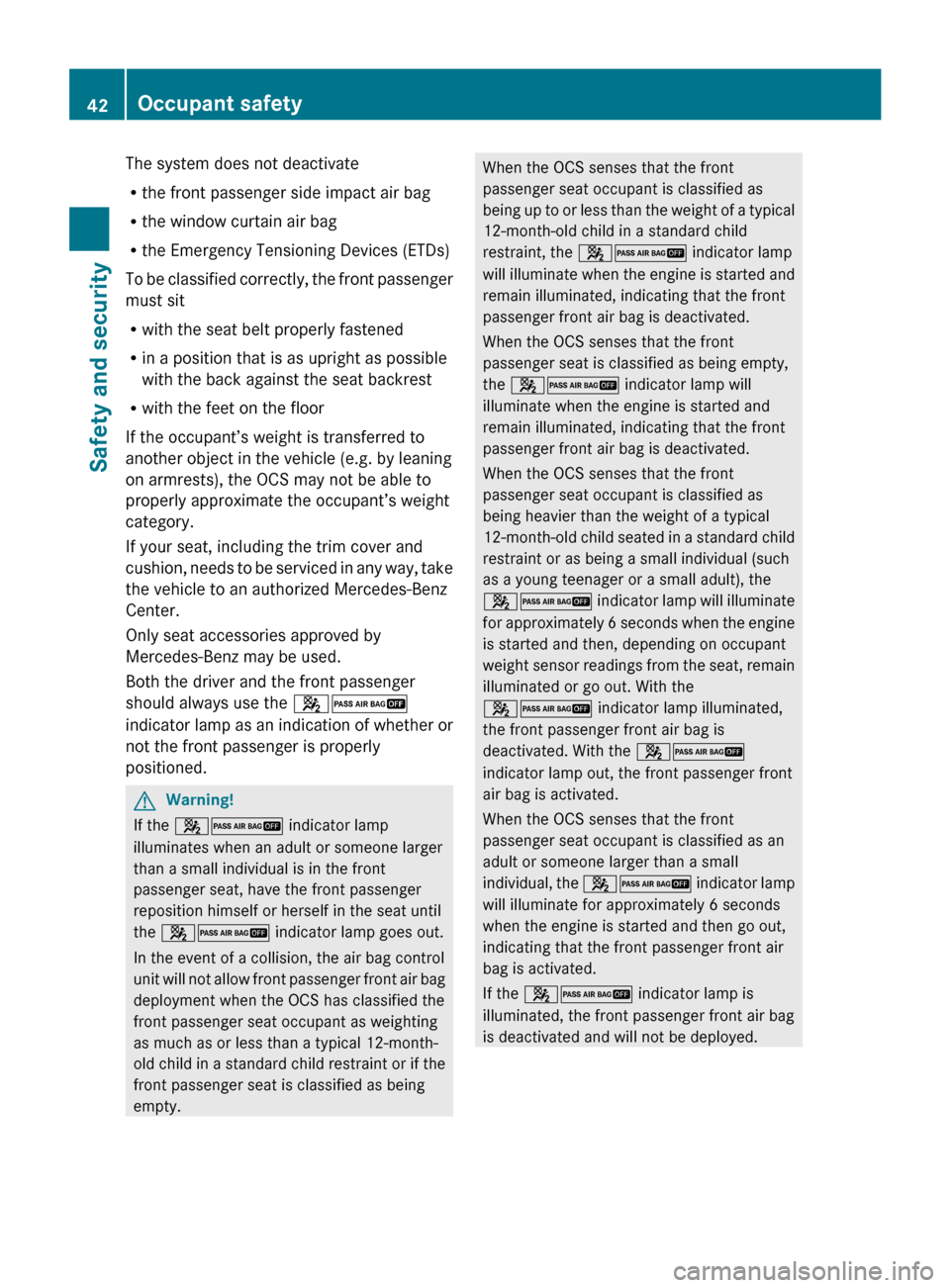
The system does not deactivate
R
the front passenger side impact air bag
R the window curtain air bag
R the Emergency Tensioning Devices (ETDs)
To be
classified correctly, the front passenger
must sit
R with the seat belt properly fastened
R in a position that is as upright as possible
with the back against the seat backrest
R with the feet on the floor
If the occupant’s weight is transferred to
another object in the vehicle (e.g. by leaning
on armrests), the OCS may not be able to
properly approximate the occupant’s weight
category.
If your seat, including the trim cover and
cushion, needs to be serviced in any way, take
the vehicle to an authorized Mercedes-Benz
Center.
Only seat accessories approved by
Mercedes-Benz may be used.
Both the driver and the front passenger
should always use the 42
indicator lamp as an indication of whether or
not the front passenger is properly
positioned. G
Warning!
If the 42 indicator lamp
illuminates when an adult or someone larger
than a small individual is in the front
passenger seat, have the front passenger
reposition himself or herself in the seat until
the 42 indicator lamp goes out.
In the event of a collision, the air bag control
unit will
not allow front passenger front air bag
deployment when the OCS has classified the
front passenger seat occupant as weighting
as much as or less than a typical 12-month-
old child in a standard child restraint or if the
front passenger seat is classified as being
empty. When the OCS senses that the front
passenger seat occupant is classified as
being
up
to or less than the weight of a typical
12-month-old child in a standard child
restraint, the 42 indicator lamp
will illuminate when the engine is started and
remain illuminated, indicating that the front
passenger front air bag is deactivated.
When the OCS senses that the front
passenger seat is classified as being empty,
the 42 indicator lamp will
illuminate when the engine is started and
remain illuminated, indicating that the front
passenger front air bag is deactivated.
When the OCS senses that the front
passenger seat occupant is classified as
being heavier than the weight of a typical
12-month-old child seated in a standard child
restraint or as being a small individual (such
as a young teenager or a small adult), the
42 indicator lamp will illuminate
for approximately 6 seconds when the engine
is started and then, depending on occupant
weight sensor readings from the seat, remain
illuminated or go out. With the
42 indicator lamp illuminated,
the front passenger front air bag is
deactivated. With the 42
indicator lamp out, the front passenger front
air bag is activated.
When the OCS senses that the front
passenger seat occupant is classified as an
adult or someone larger than a small
individual, the 42 indicator lamp
will illuminate for approximately 6 seconds
when the engine is started and then go out,
indicating that the front passenger front air
bag is activated.
If the 42 indicator lamp is
illuminated, the front passenger front air bag
is deactivated and will not be deployed. 42
Occupant safety
Safety and security
216_AKB; 3; 90, en-US
d2ureepe,
Version: 2.11.8.1 2009-05-15T11:47:50+02:00 - Seite 42
Page 48 of 500
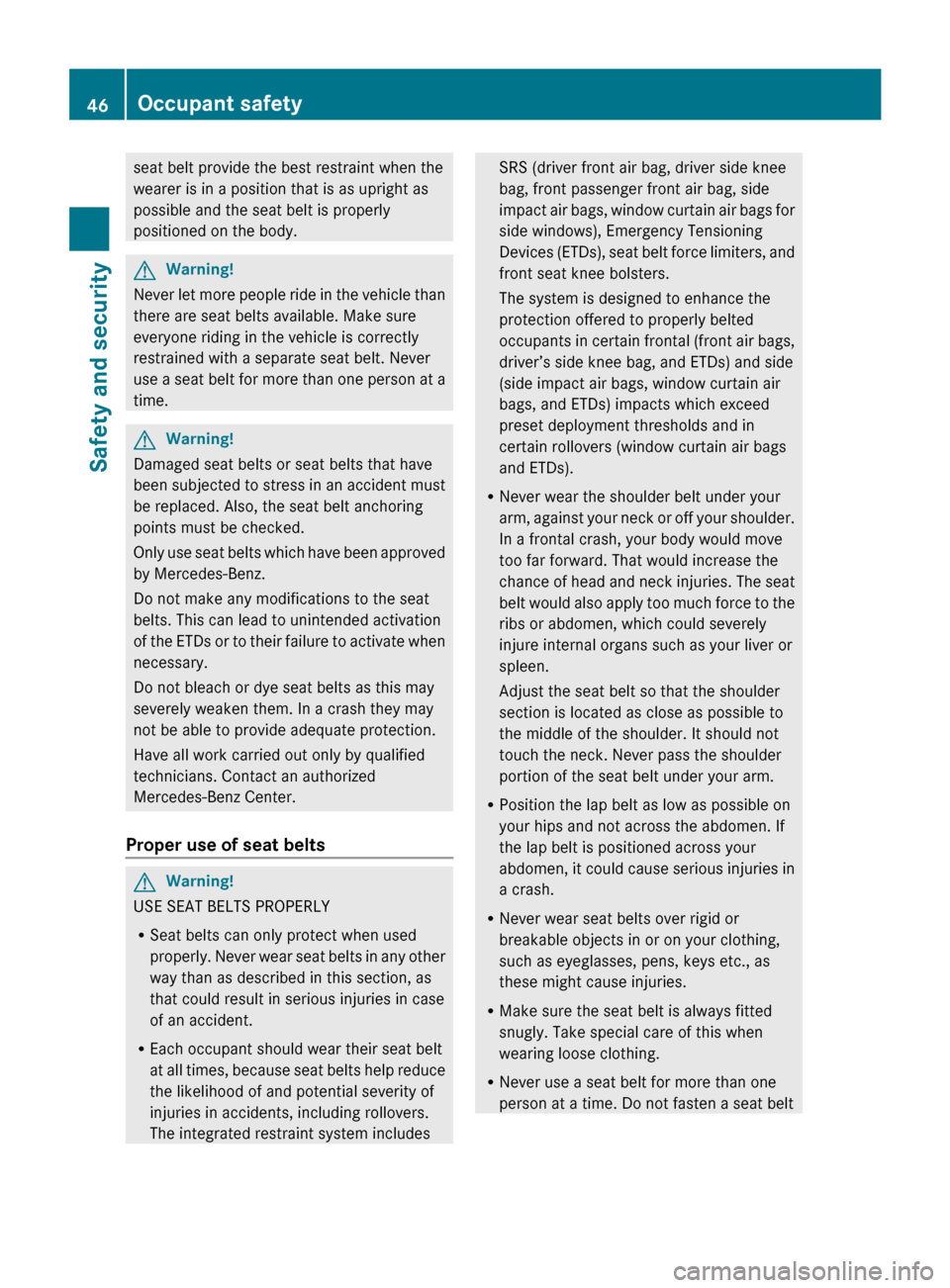
seat belt provide the best restraint when the
wearer is in a position that is as upright as
possible and the seat belt is properly
positioned on the body.
G
Warning!
Never let more people ride in the vehicle than
there are seat belts available. Make sure
everyone riding in the vehicle is correctly
restrained with a separate seat belt. Never
use a
seat belt for more than one person at a
time. G
Warning!
Damaged seat belts or seat belts that have
been subjected
to stress in an accident must
be replaced. Also, the seat belt anchoring
points must be checked.
Only use seat belts which have been approved
by Mercedes-Benz.
Do not make any modifications to the seat
belts. This can lead to unintended activation
of the ETDs or to their failure to activate when
necessary.
Do not bleach or dye seat belts as this may
severely weaken them. In a crash they may
not be able to provide adequate protection.
Have all work carried out only by qualified
technicians. Contact an authorized
Mercedes-Benz Center.
Proper use of seat belts G
Warning!
USE SEAT BELTS PROPERLY
R Seat belts can only protect when used
properly. Never
wear seat belts in any other
way than as described in this section, as
that could result in serious injuries in case
of an accident.
R Each occupant should wear their seat belt
at all times, because seat belts help reduce
the likelihood of and potential severity of
injuries in accidents, including rollovers.
The integrated restraint system includes SRS (driver front air bag, driver side knee
bag, front passenger front air bag, side
impact
air
bags, window curtain air bags for
side windows), Emergency Tensioning
Devices (ETDs), seat belt force limiters, and
front seat knee bolsters.
The system is designed to enhance the
protection offered to properly belted
occupants in certain frontal (front air bags,
driver’s side knee bag, and ETDs) and side
(side impact air bags, window curtain air
bags, and ETDs) impacts which exceed
preset deployment thresholds and in
certain rollovers (window curtain air bags
and ETDs).
R Never wear the shoulder belt under your
arm, against your neck or off your shoulder.
In a frontal crash, your body would move
too far forward. That would increase the
chance of head and neck injuries. The seat
belt would also apply too much force to the
ribs or abdomen, which could severely
injure internal organs such as your liver or
spleen.
Adjust the seat belt so that the shoulder
section is located as close as possible to
the middle of the shoulder. It should not
touch the neck. Never pass the shoulder
portion of the seat belt under your arm.
R Position the lap belt as low as possible on
your hips and not across the abdomen. If
the lap belt is positioned across your
abdomen, it could cause serious injuries in
a crash.
R Never wear seat belts over rigid or
breakable objects in or on your clothing,
such as eyeglasses, pens, keys etc., as
these might cause injuries.
R Make sure the seat belt is always fitted
snugly. Take special care of this when
wearing loose clothing.
R Never use a seat belt for more than one
person at a time. Do not fasten a seat belt 46
Occupant safety
Safety and security
216_AKB; 3; 90, en-US
d2ureepe,
Version: 2.11.8.1 2009-05-15T11:47:50+02:00 - Seite 46
Page 50 of 500
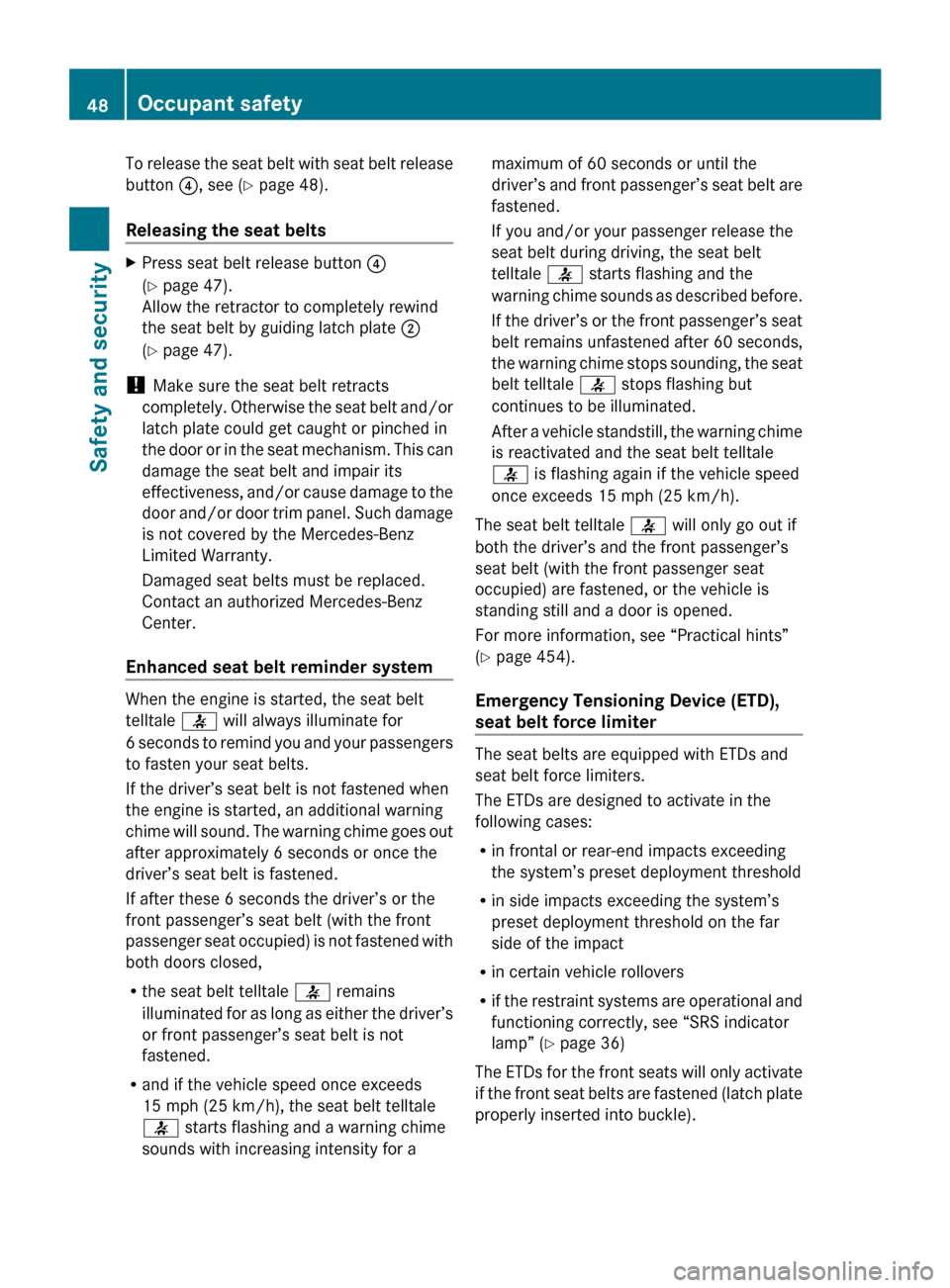
To release the seat belt with seat belt release
button
?, see ( Y page 48).
Releasing the seat belts X
Press seat belt release button ?
(Y page 47).
Allow the retractor to completely rewind
the seat belt by guiding latch plate ;
(Y page 47).
! Make sure the seat belt retracts
completely. Otherwise
the seat belt and/or
latch plate could get caught or pinched in
the door or in the seat mechanism. This can
damage the seat belt and impair its
effectiveness, and/or cause damage to the
door and/or door trim panel. Such damage
is not covered by the Mercedes-Benz
Limited Warranty.
Damaged seat belts must be replaced.
Contact an authorized Mercedes-Benz
Center.
Enhanced seat belt reminder system When the engine is started, the seat belt
telltale
7 will always illuminate for
6 seconds
to remind you and your passengers
to fasten your seat belts.
If the driver’s seat belt is not fastened when
the engine is started, an additional warning
chime will sound. The warning chime goes out
after approximately 6 seconds or once the
driver’s seat belt is fastened.
If after these 6 seconds the driver’s or the
front passenger’s seat belt (with the front
passenger seat occupied) is not fastened with
both doors closed,
R the seat belt telltale 7 remains
illuminated for as long as either the driver’s
or front passenger’s seat belt is not
fastened.
R and if the vehicle speed once exceeds
15 mph (25 km/h), the seat belt telltale
7 starts flashing and a warning chime
sounds with increasing intensity for a maximum of 60 seconds or until the
driver’s
and
front passenger’s seat belt are
fastened.
If you and/or your passenger release the
seat belt during driving, the seat belt
telltale 7 starts flashing and the
warning chime sounds as described before.
If the driver’s or the front passenger’s seat
belt remains unfastened after 60 seconds,
the warning chime stops sounding, the seat
belt telltale 7 stops flashing but
continues to be illuminated.
After a vehicle standstill, the warning chime
is reactivated and the seat belt telltale
7 is flashing again if the vehicle speed
once exceeds 15 mph (25 km/h).
The seat belt telltale 7 will only go out if
both the driver’s and the front passenger’s
seat belt (with the front passenger seat
occupied) are fastened, or the vehicle is
standing still and a door is opened.
For more information, see “Practical hints”
(Y page 454).
Emergency Tensioning Device (ETD),
seat belt force limiter The seat belts are equipped with ETDs and
seat belt force limiters.
The ETDs are designed to activate in the
following cases:
R
in frontal or rear-end impacts exceeding
the system’s preset deployment threshold
R in side impacts exceeding the system’s
preset deployment threshold on the far
side of the impact
R in certain vehicle rollovers
R if the
restraint systems are operational and
functioning correctly, see “SRS indicator
lamp” (Y page 36)
The ETDs for the front seats will only activate
if the front seat belts are fastened (latch plate
properly inserted into buckle). 48
Occupant safety
Safety and security
216_AKB; 3; 90, en-US
d2ureepe,
Version: 2.11.8.1 2009-05-15T11:47:50+02:00 - Seite 48
Page 52 of 500
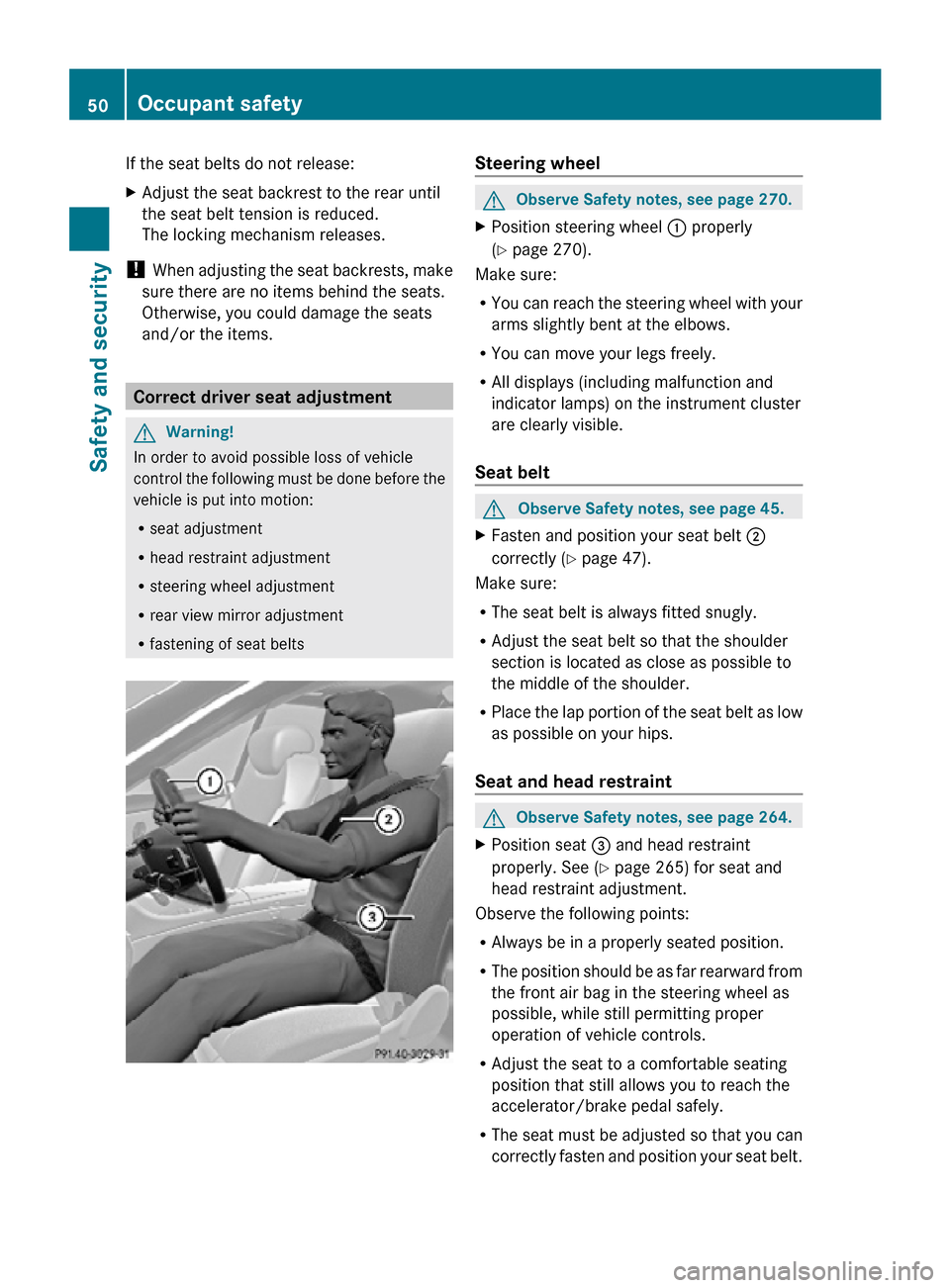
If the seat belts do not release:
X
Adjust the seat backrest to the rear until
the seat belt tension is reduced.
The locking mechanism releases.
! When adjusting the seat backrests, make
sure there are no items behind the seats.
Otherwise, you could damage the seats
and/or the items. Correct driver seat adjustment
G
Warning!
In order to avoid possible loss of vehicle
control the following must be done before the
vehicle is put into motion:
R seat adjustment
R head restraint adjustment
R steering wheel adjustment
R rear view mirror adjustment
R fastening of seat belts Steering wheel
G
Observe Safety notes, see page 270.
X Position steering wheel : properly
(Y page 270).
Make sure:
R You can reach the steering wheel with your
arms slightly bent at the elbows.
R You can move your legs freely.
R All displays (including malfunction and
indicator lamps) on the instrument cluster
are clearly visible.
Seat belt G
Observe Safety notes, see page 45.
X Fasten and position your seat belt ;
correctly (Y page 47).
Make sure:
R The seat belt is always fitted snugly.
R Adjust the seat belt so that the shoulder
section is located as close as possible to
the middle of the shoulder.
R Place the lap portion of the seat belt as low
as possible on your hips.
Seat and head restraint G
Observe Safety notes, see page 264.
X Position seat = and head restraint
properly. See ( Y page 265) for seat and
head restraint adjustment.
Observe the following points:
R Always be in a properly seated position.
R The position should be as far rearward from
the front air bag in the steering wheel as
possible, while still permitting proper
operation of vehicle controls.
R Adjust the seat to a comfortable seating
position that still allows you to reach the
accelerator/brake pedal safely.
R The seat must be adjusted so that you can
correctly fasten and position your seat belt. 50
Occupant safetySafety and security
216_AKB; 3; 90, en-US
d2ureepe,
Version: 2.11.8.1 2009-05-15T11:47:50+02:00 - Seite 50